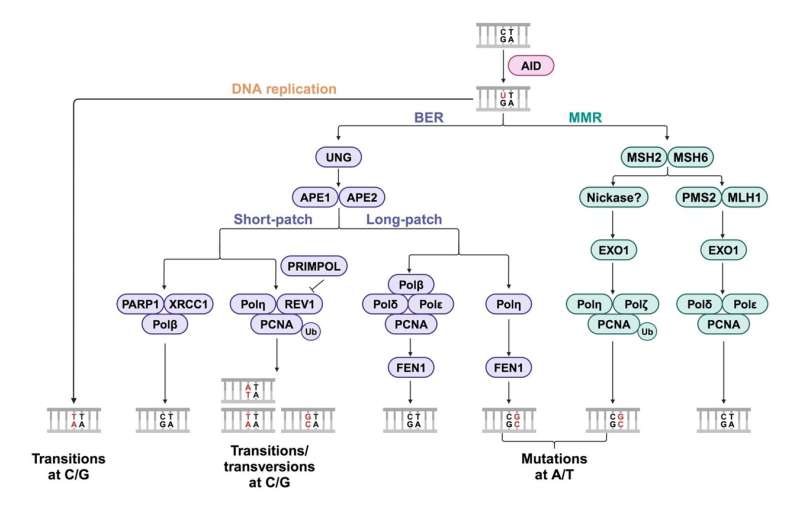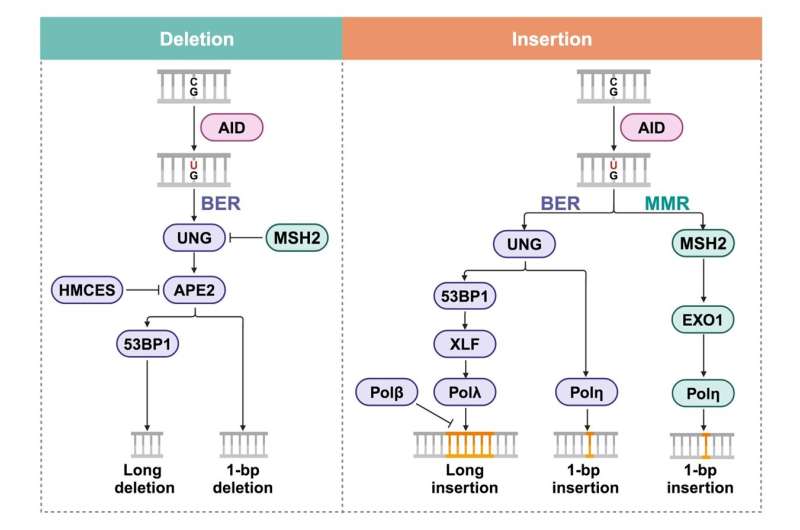This article has been reviewed according to Science X's editorial process and policies. Editors have highlighted the following attributes while ensuring the content's credibility:
fact-checked
peer-reviewed publication
trusted source
proofread
Mechanisms of antibody gene diversification during somatic hypermutation

In a recent online publication in Science China Life Sciences, researchers from the laboratory of Leng-Siew Yeap at the Shanghai Institute of Immunology, Shanghai Jiao Tong University School of Medicine published a review article entitled "Molecular Mechanisms of DNA Lesion and Repair During Antibody Somatic Hypermutation."
The review comprehensively summarizes the mechanisms involved in the generation of antigen-specific diversified antibodies, with a particular focus on the mechanisms that generate high-frequency point mutations and low-frequency deletions and insertions (indels) in antibody genes.
Antibodies, like specialized immunoglobulin (Ig) proteins produced and secreted by B cells in the immune system, play an essential role in recognizing and binding antigens to combat pathogen invasion. However, the diversity and efficacy of antibodies are not inherent properties but are achieved through finely regulated molecular mechanisms.
Somatic hypermutation of antibody genes represents a critical step in antibody diversification. This process involves a series of mutational events, including point mutations and indels, which alter the amino acid sequence of antibodies and affect their affinity for antigens. The mechanisms underlying these mutational events have been a focus of basic immunological research.
During SHM, activation-induced cytidine deaminase (AID) can bind to single-stranded DNA and convert cytosine (C) to uracil (U), resulting in U:G mismatches. These mismatches can be recognized by factors involved in the base excision repair (BER) or mismatch repair (MMR) pathways, resulting in point mutation and indels. This review systematically elucidates the molecular mechanisms underlying the generation of these mutational events.
Mutations at C/G sites are primarily generated by DNA replication or BER pathways, whereas mutations at A/T sites are primarily generated by the MMR pathway. Indels are primarily generated through the BER pathway, with 1-bp insertions potentially occurring through the MMR pathway.

Translesion synthesis (TLS) polymerases play a critical role during SHM. This review comprehensively summarizes the different functions of nine TLS polymerases during SHM, such as Polη, which is mainly responsible for generating mutations at A/T sites and 1-bp insertions, REV1, which is mainly involved in C/G site replacement mutations, and Polλ, which is mainly involved in generating long insertions.
In conclusion, this review provides a comprehensive overview of the molecular mechanisms underlying various mutational outcomes and extensively summarizes the functional characteristics of TLS polymerases during SHM, providing theoretical foundations for vaccine design and the generation of broadly neutralizing antibodies that often harbor extraordinarily high mutations, including rare indel events.
More information: Qian Hao et al, Molecular mechanisms of DNA lesion and repair during antibody somatic hypermutation, Science China Life Sciences (2024). DOI: 10.1007/s11427-024-2615-1



















